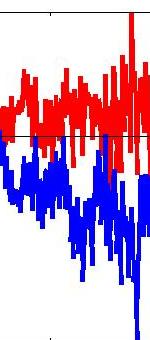In 2007 I was awarded a New Investigator Award from the MRC to investigate vertical disparity. As part of this I ordered a new projector system from Virtalis. This uses two F20 sx+ single-chip DLP projectors from Projection Design. These projectors are relatively unusual amongst single-chip DP projectors in that they are genlocked to the video input, meaning that the two projectors can be synchronised — essential for my purposes. I hope they will prove superior to my Matrix 2500 LCD projectors in several ways:
- They are much smaller and lighter and generate much less heat. This means they can be positioned right up against the wall, giving me an extra metre’s throw distance and hence a larger image — important for my vertical disparity project.
- For the same reason they can be positioned much closer together. This reduces the amount of vertical lens shift needed to bring the images into registration, reducing image distortion and improving the alignment between the two projectors.
- They have much better contrast (2500:1 compared to 700:1 for the Matrix 2500), so their “black” is much blacker, minimising edge effects at the boundary of the projected image. With my Matrix 2500s, I could display white points with vertical disparity on a notionally black screen, but in fact the “black” screen would appear quite a bright grey, so the boundaries of the projected images provided a zero disparity signal.
- They are higher resolution, 1400×1050 pixels (SXGA+) compared to 1280×1024 (SXGA).
- Their DLP technology means they have a fast temporal response, so they should be able to display motion stimuli without introducing contrast artefacts.
- They are 10-bit, so in theory, using something like the DATAPixx system, we should be able to get 1024 graylevels.
I have also moved to a new lab, which together with the new projectors is allowing me a much longer throw distance, some 3.4m. I now have a very large screen which is fixed to the walls, dividing the room in two (~2.7m wide x 2.0m high). This screen is made of Filmscreen 150 from Stewart, which was recommended to me by Virtalis as having both good polarisation-preserving properties, and also much less hot-spotting than my perspex Screen-Tech screen. I was concerned that a fabric screen would oscillate too much in the air currents, introducing misalignments between the images. However, this does not seem to be a major problem (aided of course by the large throw distance and short separation between the projectors, meaning that their two beams are striking the screen at approximately the same angle).
The display computer is located near the projectors. To said in developing code, the signal to each projector is split using a DVI splitter box, and copied to a flatscreen monitor on the desk. This means that we can develop code with the projectors turned off, using one monitor for the Matlab command window and editor, and the other two monitors to display the left and right images. We can also control the display computer from the observer’s side of the screen using a wireless keyboard and Gyration mouse, which is handy. All code is run off the network rather than the local hard disk, and similarly the results are written to the network. This means that when I am piloting a project, I can sit on the observer’s side of the screen, using my laptop to modify the stimulus code and view my data over the network. I then just use the wireless keyboard to set the modified code running on the display computer. This means I don’t have to walk back and forth between the two sides of the screen. This is all shown in the diagram below:

The projectors can be controlled remotely with a single handset, which can talk to either projector individually or both together. Certain simple operations, e.g. turning the projectors on and off or blanking their display, can be done over the web. More detailed information for lab members is available here.
The behaviour of this system is documented in more detail below:
- Interocular cross-talk: no problem, <2% of the light presented in one eye leaks through to the other. The results are slightly different depending on whether they are measured at high or low contrast, which I suspect indicates non-linearities in the photometer.
- Synchronisation: no problem; if a single Psychtoolbox window is opened across both projectors, the image is updated at the same time on both projectors, to sub-millisecond precision.
- Alignment: no problem; we can get alignment to within a pixel over most of the image, and no worse than 2 pixels even in the periphery.
- Ambient light: no problem; experimenters can use a computer monitor in the area of the lab behind the rear projection screen without this being visible to the observer.
- Relative brightness: Currently (6th June 2008) with both projectors on their default settings, the bottom (left) projector projects about half the luminance of the top (right) projector. The precise values vary depending where you point the photometer, but are around 200 cd/m2 for the left image (top projector) and 300 for the right (bottom). The ratio is constant.
- Gamma correction: no problem (although, lab members nota bene, since taking this gamma table, we have reduced the brightness and white boost to improve the life of the filters, so need to redo the gamma correction).
- Screen co-ordinates: describing how (X,Y) coordinates in Psychophysics Toolbox code map onto position on the screen.




















